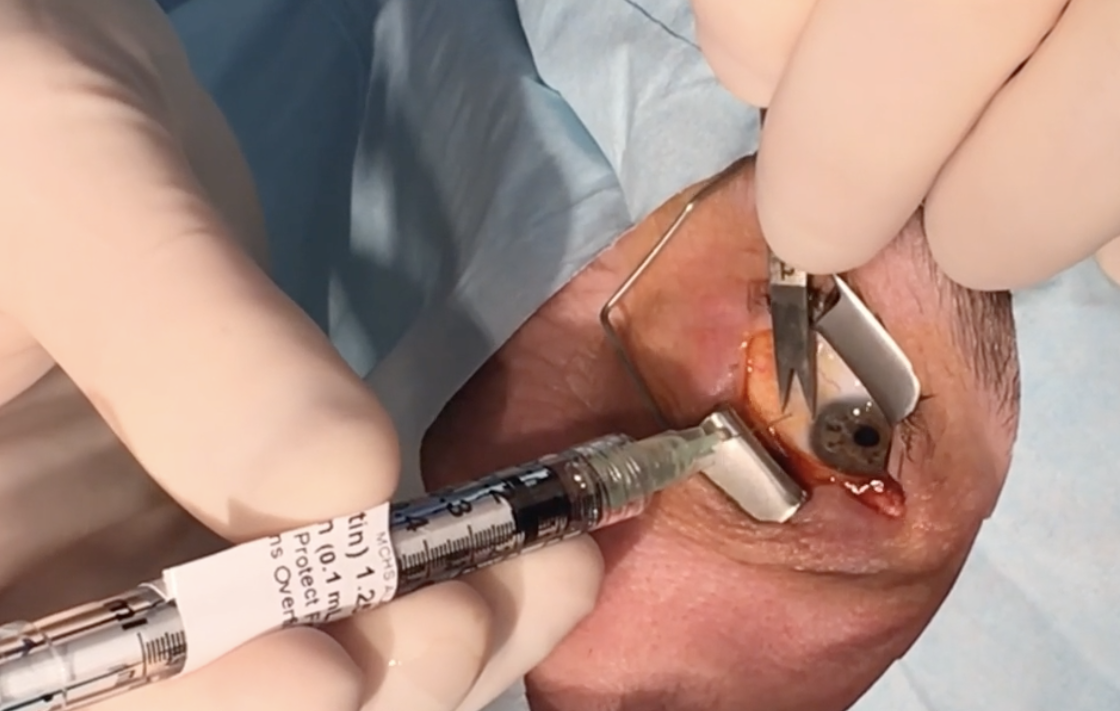 |
| Lockdowns have caused many wet AMD patients to miss or skip anti-VEGF injections, which has resulted in negative visual outcomes. Photo: Leonid Skorin Jr., DO, OD, MS. Click image to enlarge. |
As COVID-19 continues to have rippling effects across the globe, researchers look for clues on how eyecare was impacted during the lockdown and ways to apply lessons learned two years into the pandemic. Two recent studies published in Retina considered how COVID has impacted the continuity of care for wet AMD patients, with one international study citing notable vision loss based on fewer anti-VEGF treatments and the other suggesting an “injection-only” approach was effective in managing these individuals.
The first investigation considered the lockdown’s impact on about 5,800 eyes of 4,700 individuals who had either wet AMD, DME or RVO and resided in either Australia, France, Ireland, Italy, the Netherlands, New Zealand, Spain or Switzerland.1 All participants received anti-VEGF injections prior, during and after the national lockdown. The baseline visit was defined as the last visit within three months prior to lockdown, and pre- and post-lockdown periods were six months before and after lockdown.
The researchers found eyes with wet AMD (n=4,649) lost vision in all countries in proportion to the reduced number of injections. VA change post-lockdown ranged from -0.4 to -3.8 logMAR letters, while the number of injections/visits decreased from 4-5/4-7 to 2-4/2-4 post-lockdown. Vision loss occurred even after the condition had been prioritized in all the national and international clinical guidelines, the authors noted.
Clinical outcomes in DME and RVO eyes were slightly different, as intravitreal injections for both were deferred in favor of wet AMD patients in all the participating countries. Specifically, the VA change in DME (n=654) and RVO (n=479) eyes ranged from -2.8 to +1.7 letters and -1.6 to +0.1 letters, respectively. Additionally, the number of injections/visits decreased from 2.5-5/4-6 to 1-3/2-4 in DME eyes and from 3-5.5/4-5 to 1-3.5/2-3.5 in RVO eyes.
In general, countries that only reduced one injection (Australia, France and the Netherlands) had better visual outcomes (VA loss of less than one letter) compared with those that reduced their treatment rate by two injections (Ireland, Italy, Spain), with the exception of New Zealand, which had one or less letter loss and two fewer injections. Notably, the extended treatment interval of the first post-lockdown injection likely indicated at least one missed injection due to cancellations and rescheduling of appointments, the researchers explained.
At six months after the lockdown, RVO patients had the highest treatment dropout rate at 28%, followed by 27% for individuals with DME and 20% for wet AMD patients.
These findings may help clinicians to prepare strategies to mitigate vision loss in future pandemics, the investigators suggested. “It appears appropriate to prioritize intravitreal therapy for eyes with wet AMD in this scenario,” they wrote in their paper.
The second investigation found patients who temporarily stopped IVT injections during the lockdown showed increased exudative activity with worsened visual and anatomical parameters compared with patients who pursued an “injection-only” treatment approach.2 While anatomical parameters recovered to pre-lockdown values, visual function did not recover entirely in patients who delayed treatment.
This study was a retrospective review of 314 patients (394 eyes) who were scheduled to receive IVT injections during the Swiss lockdown, which occurred from March 17, 2020, until April 27, 2020. Researchers compared outcomes of 215 individuals who continued to receive scheduled IVT treatment without clinical consultation and 179 patients who completely deferred treatment.
Not surprisingly, the baseline and post-lockdown VA were about the same in those who continued treatment. On the other hand, participants who deferred treatment had a significant deterioration in their vision compared with baseline. Although these patients’ VA improved slightly after injections resumed, it didn’t reach baseline levels.
Also of note: central subfield thickness remained stable in the individuals who continued their treatment regimen. However, this measure increased in patients who deferred injections, while it returned to pre-lockdown levels after restarting treatment.
The findings suggest that visual benefits of IVT therapy may be lost if regular dosing is not maintained, showing no difference in relation to the type of anti-VEGF agent in use, the researchers suggested.
Furthermore, IVT treatment during a lockdown was a never-before-seen unique scenario that could reoccur in the future, they added.
“Our experience denotes the feasibility of an ‘injection-only’ management plan for implementation in future pandemics, especially in a cohort of patients following an observe-and-plan regimen,” the researchers wrote in their paper.
The injection-only model, where patients bypass VA measurement, ophthalmology consultation and OCT imaging, has been previously proposed to decrease the treatment burden of wet AMD patients, but it is only possible once the fixed treatment interval has been established for each individual patient, the investigators explained.
In the current study setting, the individual fixed treatment interval was already determined due to existing adherence of the observe-and-plan regimen, which allowed for such favorable results, they suggested.
1. Zarranz-Ventura J, Nguyen V, Creuzot-Garcher C, et al. International impact of the COVID-19 pandemic lockdown on intravitreal therapy outcomes: Fight Retinal Blindness registry. Retina. December 1, 2021. [Epub ahead of print]. |

